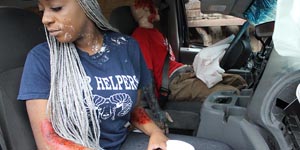Fanshawe holds mock disaster training exercise
Fanshawe took part in a mock disaster training exercise titled Fanshawe Exercise 50, which involved a number of college and London first responders on May 25.
Emergency medical services (EMS) arrived at Fanshawe to respond to a mock emergency that took place in front of B building on May 25.
The incident, a Fanshawe Emergency Management Office (EMO), disaster training exercise, titled Fanshawe Exercise 50, was organized by a core planning team that included input from Bob Earle, manager of EMO, representatives from the police, fire and paramedics and other faculty members of the college.
According to Earle, the process of planning the scenario started in January when learning outcomes and training objectives were determined.
“We put together a scenario that tested our internal responses at the college as well as our community partners in the emergency response component. It could potentially happen on campus, something that has major significance and something that would be a challenge for us to respond to,” Earle said.
According to a Fanshawe Corporation Communications press release, on behalf of EMO, this year's event was focused on a Mass Causality Incident (MCI).
Preparation of the scene started at 3 a.m., and consisted of an overturned school bus, two trucks with extensive collision damage and chemical spill products littered on the ground.
Inside the vehicles were actors who pretended to be injured for the duration of the event, with graphic makeup injuries and simulated vomit.
“It involved a motor vehicle collision with some chemical elements that produced upwards of 17 casualties so it was a challenge for all the emergency services responding to provide an adequate response. We were all working together towards the same objectives and making sure that we bring this sort of situation to a timely conclusion,” Earle said.
Students enrolled in Fanshawe's police foundations program, advanced care paramedic, paramedic, EMO and other affiliated programs and community members were involved in the simulation as part of their learning experience.
“The learning objectives for [students] were to see an incidence response in real time so this is the kind of thing they don't have an opportunity to experience in a classroom. The only way they can see a response to a large-scale emergency is to see one taking place,” Earle said.
Approximately 200 people were involved in the exercise including bystanders, co-ordinators, patients and EMS workers.
The day unfolded with EMS arriving on scene, safely evacuating passengers from the vehicles, treating the injured and washing the chemicals off those that were contaminated.
Earle explained that some possible opportunities for improvement were recognized, but also aspects that went according to plan.
“I'm very pleased with the college response, the interplay between our responders and the municipal responders and the fact that we wrapped up ahead of time is a testament to the fact that it was done in a very timely manner so I was very pleased with the result,” Earle said. Click on the thumbnails below to view a larger version of each image.

























